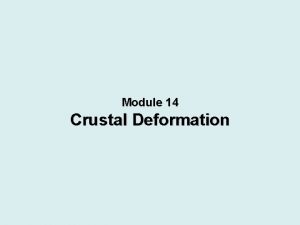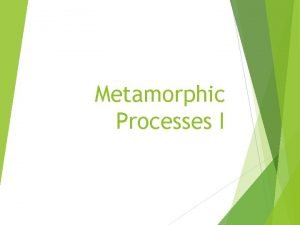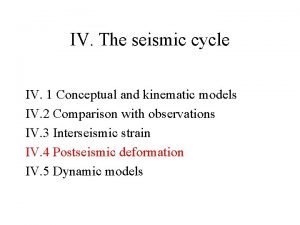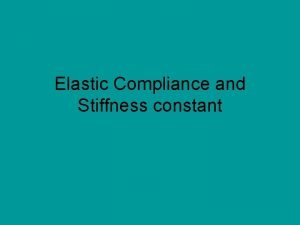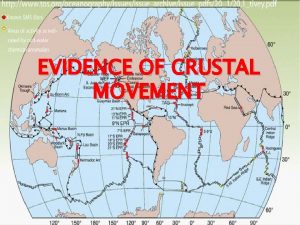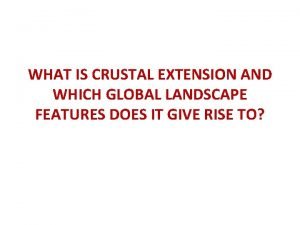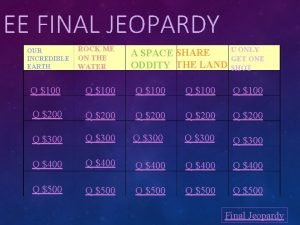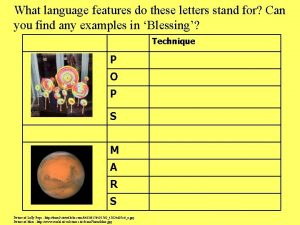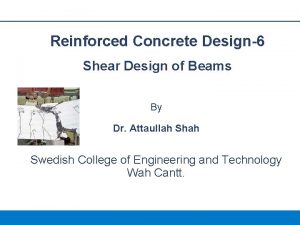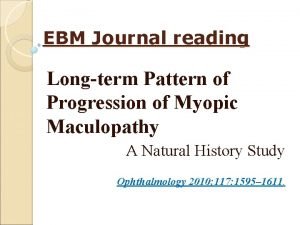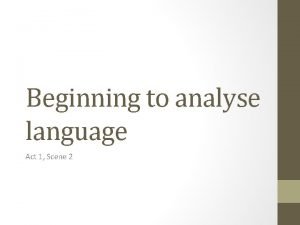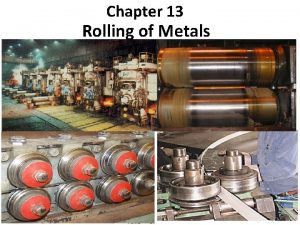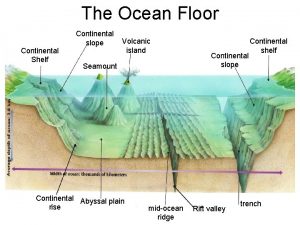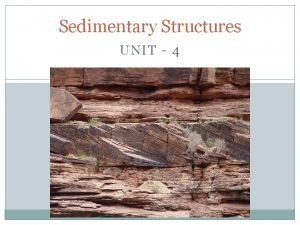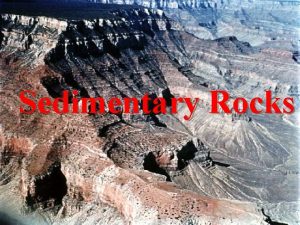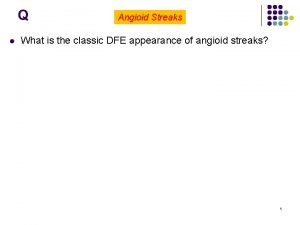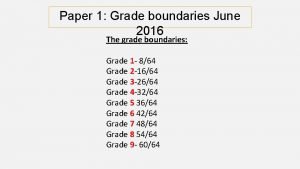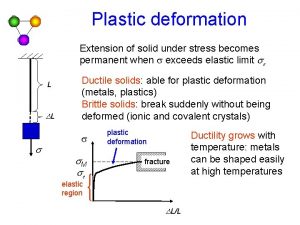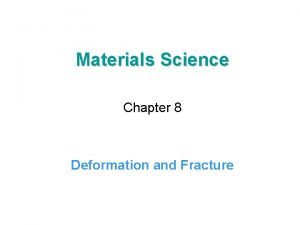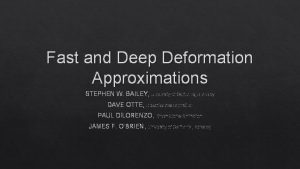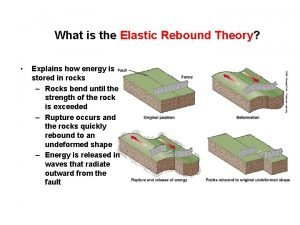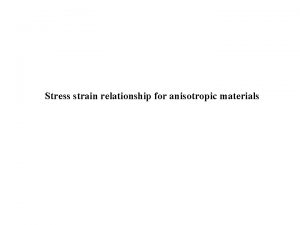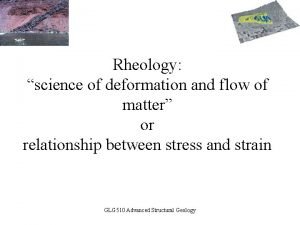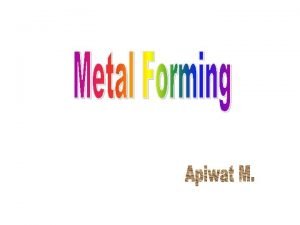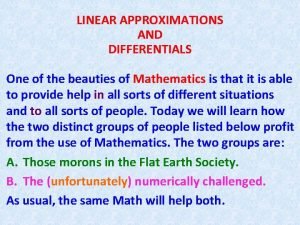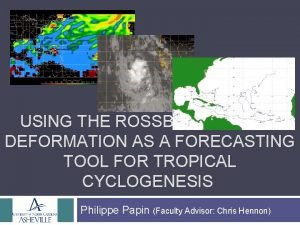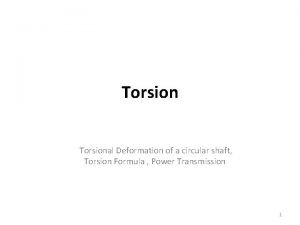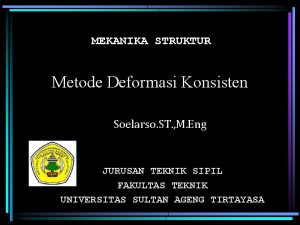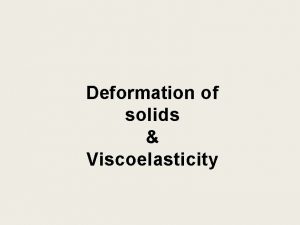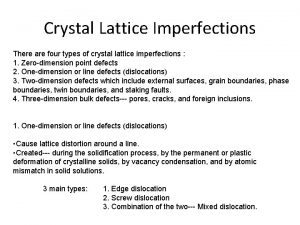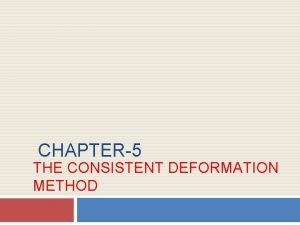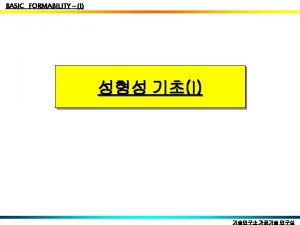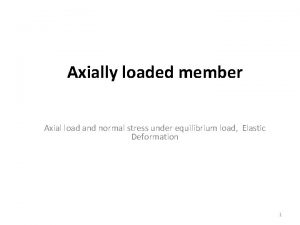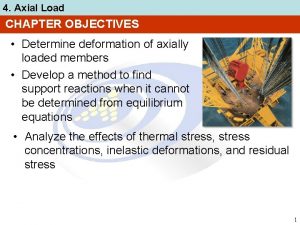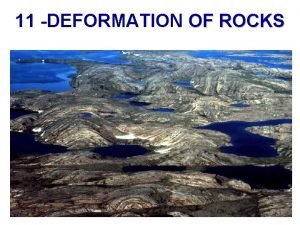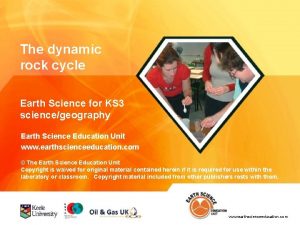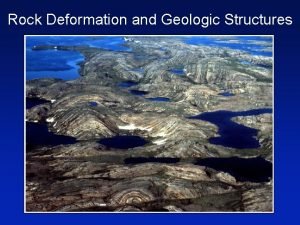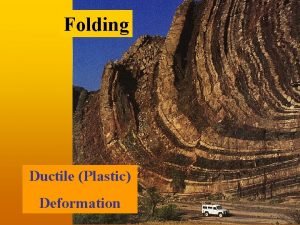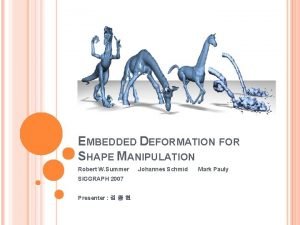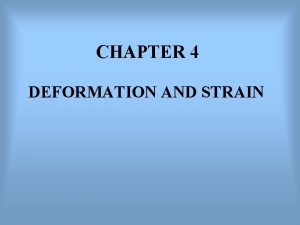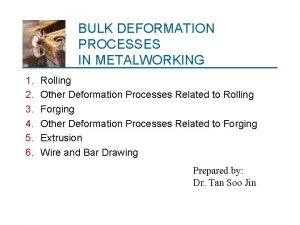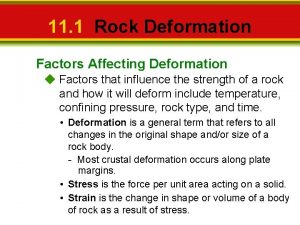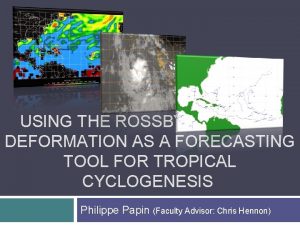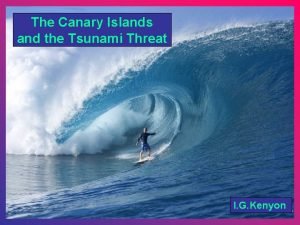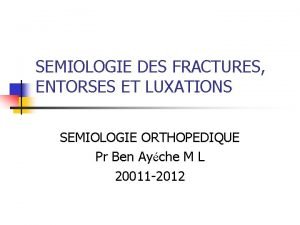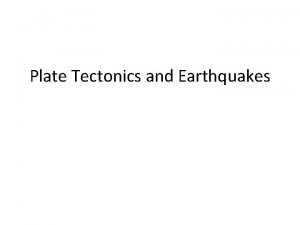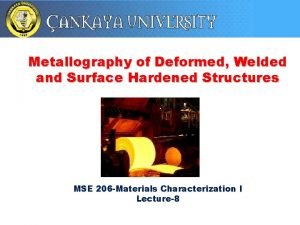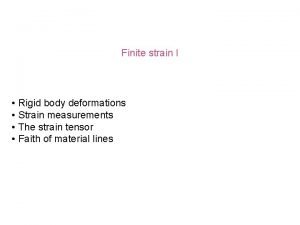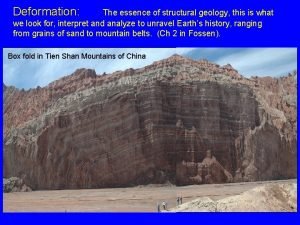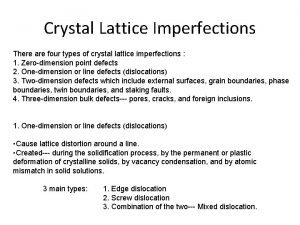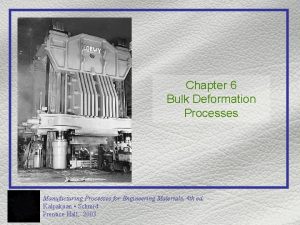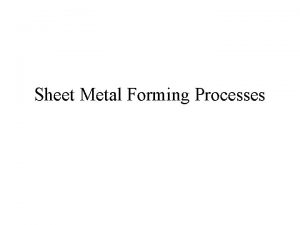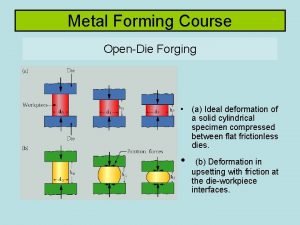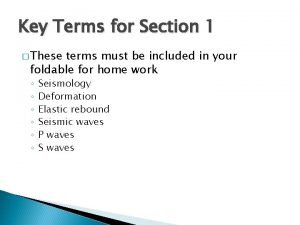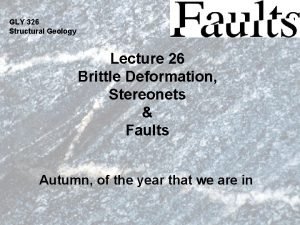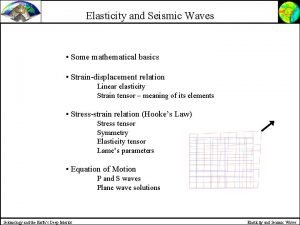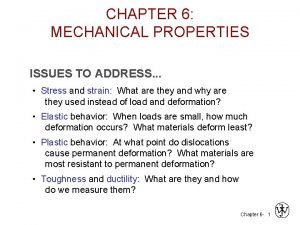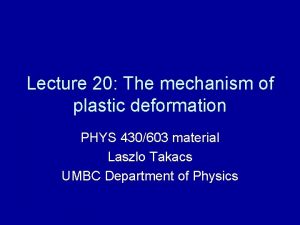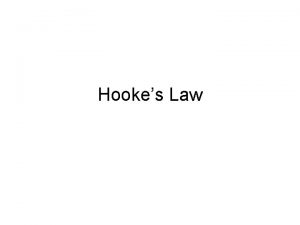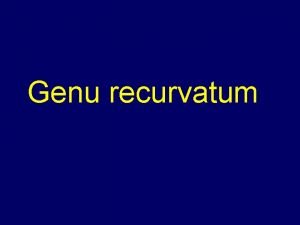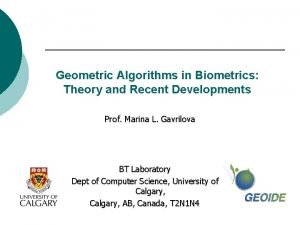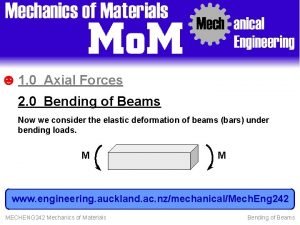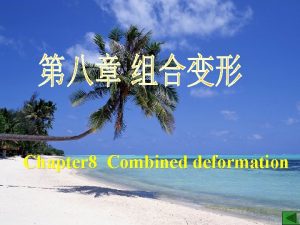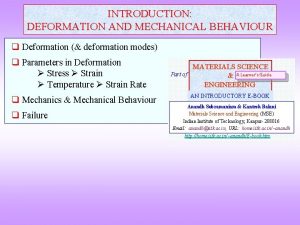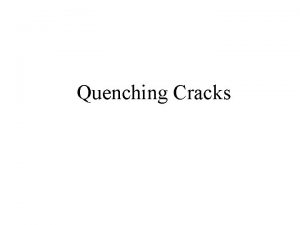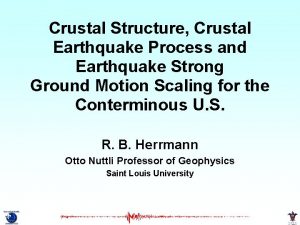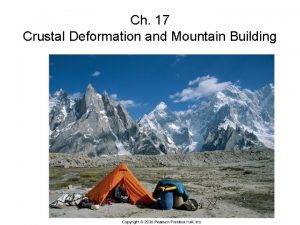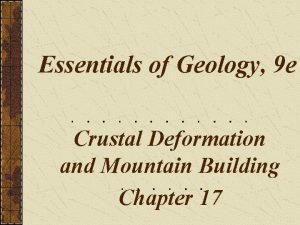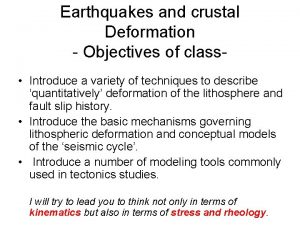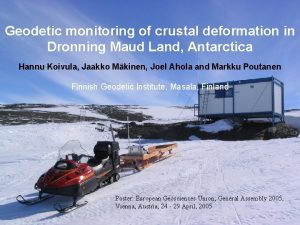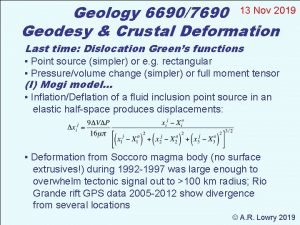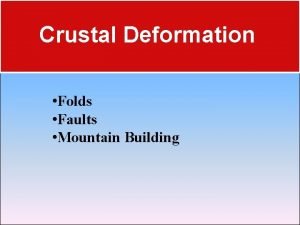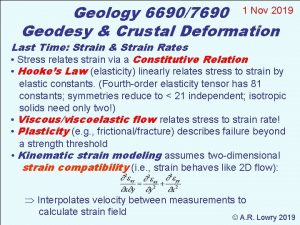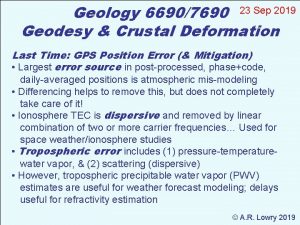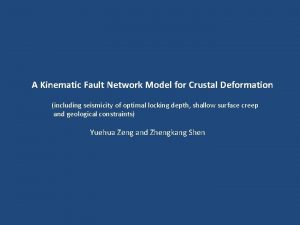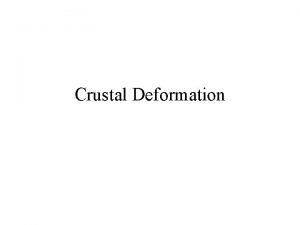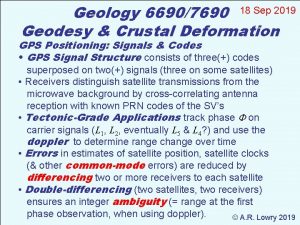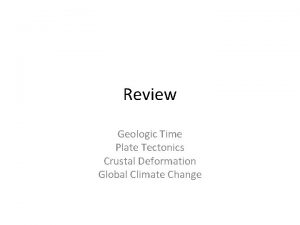Chapter 11 Crags Cracks and Crumples Crustal Deformation













































































- Slides: 77

Chapter 11 Crags, Cracks, and Crumples: Crustal Deformation and Mountain Building LECTURE OUTLINE earth Portrait of a Planet Third Edition © 2008 W. W. Norton & Company, Inc. Earth: Portrait of a Planet, 2 nd edition, by Stephen Marshak Chapter 11: Crags, Cracks, and Crumples: Crustal Deformation and Mountain Building

Crags, Cracks, and Crumples: Crustal Deformation and Mountain Building Prepared by Ronald Parker Earlham College Department of Geosciences Richmond, Indiana

Mountains < Attractive landscape features for humans. = Provide beautiful scenery. = Refuge from the mundane. = Inspire poetry and art. < Mountains provide vivid evidence of tectonic activity. < They embody… = Uplift. = Deformation. = Metamorphism. Earth: Portrait of a Planet, 2 nd edition, by Stephen Marshak Chapter 11: Crags, Cracks, and Crumples: Crustal Deformation and Mountain Building

Mountain Belts < Mountains frequently occur in elongate, linear belts. < Mountains are constructed by tectonic plate interactions in a process called orogenesis. Earth: Portrait of a Planet, 2 nd edition, by Stephen Marshak Chapter 11: Crags, Cracks, and Crumples: Crustal Deformation and Mountain Building

Mountains < Mountain building involves… = Structural deformation. = Jointing. = Faulting. = Folding. = Partial melting. = Foliation. = Metamorphism. = Glaciation. = Erosion. = Sedimentation. < Constructive processes build mountains up; destructive processes tear them back down again. Earth: Portrait of a Planet, 2 nd edition, by Stephen Marshak Chapter 11: Crags, Cracks, and Crumples: Crustal Deformation and Mountain Building

Orogenic Belts < Mountains are born and have a finite lifespan. = Young mountains are high, steep, and growing upward. = Middle-aged mountains are dissected by erosion. = Old mountains are deeply eroded and often buried. < Ancient orogenic belts are found in continental interiors. = Orogenic continental crust is too buoyant to subduct. = Hence, if it escapes erosion it is usually preserved. Earth: Portrait of a Planet, 2 nd edition, by Stephen Marshak Chapter 11: Crags, Cracks, and Crumples: Crustal Deformation and Mountain Building

Crustal Deformation < Orogenesis causes deformation, consisting of… = Bending. = Breaking. = Tilting. = Squashing. = Stretching. = Shearing. < Deformation is a force applied to rock. < Changes in shape via deformation are called strain. < The study of deformation is called structural geology. Earth: Portrait of a Planet, 2 nd edition, by Stephen Marshak Chapter 11: Crags, Cracks, and Crumples: Crustal Deformation and Mountain Building

Deformation < Deformation strain creates geologic structures. = Joints – Fractures that have no offset. = Folds – Layers that are bent by slow plastic flow. = Faults – Fractures that are offset. = Foliation – Planar metamorphic fabric. Earth: Portrait of a Planet, 2 nd edition, by Stephen Marshak Chapter 11: Crags, Cracks, and Crumples: Crustal Deformation and Mountain Building

Deformation < Deformed terrane passes into undeformed terrane. = Undeformed (unstrained). 4 Horizontal beds. 4 Spherical sand grains. 4 Flat-lying clays. 4 No folds or faults. Earth: Portrait of a Planet, 2 nd edition, by Stephen Marshak Chapter 11: Crags, Cracks, and Crumples: Crustal Deformation and Mountain Building

Deformation < Deformed terrane passes into undeformed terrane. = Deformed (strained). 4 Tilted beds. 4 Metamorphic alteration. a. Sand = Quartzite. a. Clay = Slate, phyllite, schist, or gneiss. 4 Folding and faulting. Earth: Portrait of a Planet, 2 nd edition, by Stephen Marshak Chapter 11: Crags, Cracks, and Crumples: Crustal Deformation and Mountain Building

Deformation < Deformation results in one or all of the following. . . = Translation – Change in location. = Rotation – Change in orientation. = Distortion – Change in shape. < Deformation is often easy to see. Earth: Portrait of a Planet, 2 nd edition, by Stephen Marshak Chapter 11: Crags, Cracks, and Crumples: Crustal Deformation and Mountain Building

Strain < Changes in shape caused by deformation. = Stretching – Pulling apart. = Shortening – Compressing, squeezing. = Shear – Sliding past. < Elastic strain – Reversible change in shape. < Permanent strain – Irreversible change in shape. < Two types of permanent strain: brittle and ductile. Earth: Portrait of a Planet, 2 nd edition, by Stephen Marshak Chapter 11: Crags, Cracks, and Crumples: Crustal Deformation and Mountain Building

Deformation Types < Two major types: brittle and ductile. = Brittle deformation – Rocks break by fracturing. 4 Brittle deformation occurs in the shallow crust. < A transition between the two occurs at 10 -15 km depth. Earth: Portrait of a Planet, 2 nd edition, by Stephen Marshak Chapter 11: Crags, Cracks, and Crumples: Crustal Deformation and Mountain Building

Deformation Types < Two major types: brittle and ductile. = Ductile deformation – Rocks deform by flow and folding. 4 Ductile deformation occurs in the deeper crust. < A transition between the two occurs at 10 -15 km depth. Earth: Portrait of a Planet, 2 nd edition, by Stephen Marshak Chapter 11: Crags, Cracks, and Crumples: Crustal Deformation and Mountain Building

Causes of Deformation < Strain is the result of deformation, but what causes it? = Caused by force acting on rock, a phenomenon called stress. < Stress is the force applied across an area. = A large force per area results in much deformation. = A small force per area results in little deformation. Earth: Portrait of a Planet, 2 nd edition, by Stephen Marshak Chapter 11: Crags, Cracks, and Crumples: Crustal Deformation and Mountain Building

Causes of Deformation < Types of stress: = Compressional – Squeezing. = Tensional – Pulling apart. = Shear – Sliding past. < Tectonic collision produces horizontal compression. = Large scale. = Most common type of deformation. Earth: Portrait of a Planet, 2 nd edition, by Stephen Marshak Chapter 11: Crags, Cracks, and Crumples: Crustal Deformation and Mountain Building

Stress < Pressure – Object feels the same stress on all sides. Earth: Portrait of a Planet, 2 nd edition, by Stephen Marshak Chapter 11: Crags, Cracks, and Crumples: Crustal Deformation and Mountain Building

Stress < Compression – Squeezing (greater stress in 1 direction). = Tends to thicken material. Earth: Portrait of a Planet, 2 nd edition, by Stephen Marshak Chapter 11: Crags, Cracks, and Crumples: Crustal Deformation and Mountain Building

Stress < Extension – Pull apart (greater stress in 1 direction). = Tends to thin material. Earth: Portrait of a Planet, 2 nd edition, by Stephen Marshak Chapter 11: Crags, Cracks, and Crumples: Crustal Deformation and Mountain Building

Stress < Shear – Blocks of rock sliding past one another. = Crust is neither thickened or thinned. Earth: Portrait of a Planet, 2 nd edition, by Stephen Marshak Chapter 11: Crags, Cracks, and Crumples: Crustal Deformation and Mountain Building

Geologic Structures < Geometric features created by deformation. = Folds, faults, joints, etc. = Often preserve information about stress fields. < 3 -D structural orientation is described by strike and dip. = Strike – Horizontal intersection with a tilted surface. = Dip – Angle of surface down from the horizontal. Earth: Portrait of a Planet, 2 nd edition, by Stephen Marshak Chapter 11: Crags, Cracks, and Crumples: Crustal Deformation and Mountain Building

Measuring Structures < Dip is always… = Perpendicular to strike. = Measured downslope. < Linear structures measure similar properties. = Bearing (compass direction). = Plunge – Angle from the horizontal. < Strike and dip measurements are common. Earth: Portrait of a Planet, 2 nd edition, by Stephen Marshak Chapter 11: Crags, Cracks, and Crumples: Crustal Deformation and Mountain Building

Joints < Planar rock fractures without offset. < Result from tensional tectonic stresses. < Systematic joints occur in parallel sets. < Minerals can fill joints to form veins. < Joints control weathering of rock. Earth: Portrait of a Planet, 2 nd edition, by Stephen Marshak Chapter 11: Crags, Cracks, and Crumples: Crustal Deformation and Mountain Building

Faults < Planar fractures offset by movement across the break. < Faults are abundant and occur at a variety of scales. < Faults may be active or inactive. < Sudden movements along faults cause earthquakes. < Faults vary by type of stress and crustal level. = Compression. = Tension. = Shear. = Brittle (shallow). = Ductile (deep). Earth: Portrait of a Planet, 2 nd edition, by Stephen Marshak Chapter 11: Crags, Cracks, and Crumples: Crustal Deformation and Mountain Building

Faults < Faults may offset large blocks of Earth. < The amount of offset is a measure called displacement. < The San Andreas (below) - Displacement of 100 s of kms. = The recently developed stream is offset ~ 100 m. Earth: Portrait of a Planet, 2 nd edition, by Stephen Marshak Chapter 11: Crags, Cracks, and Crumples: Crustal Deformation and Mountain Building

Fault Movement < The direction of relative block motion… = Reflects the dominant type of crustal stress. = Defines the type of fault. < All motion is relative. = To help visualize fault motion… 4 Imagine that one block is stationary (fixed in place). 4 Then, imagine that faulting moves the other block. Earth: Portrait of a Planet, 2 nd edition, by Stephen Marshak Chapter 11: Crags, Cracks, and Crumples: Crustal Deformation and Mountain Building

Fault Classification < Fault plane orientation. = Vertical. = Horizontal. = Dipping. < Relative motion of the offset blocks. = Dip slip – Blocks move parallel to fault plane dip. = Strike slip – Blocks move parallel to fault plane strike. = Oblique slip – Combination of dip-slip and strike-slip. Earth: Portrait of a Planet, 2 nd edition, by Stephen Marshak Chapter 11: Crags, Cracks, and Crumples: Crustal Deformation and Mountain Building

Fault Orientation < On a dipping fault, the blocks are classified as the… = Hanging wall block (above the fault), and the. . . = Footwall block (below the fault). < Standing in a tunnel excavated along the fault… = Your head is near the hanging wall block. = You are standing on the foot wall block. Earth: Portrait of a Planet, 2 nd edition, by Stephen Marshak Chapter 11: Crags, Cracks, and Crumples: Crustal Deformation and Mountain Building

Recognizing Faults < Continuous layers in rock are displaced across a fault. < Faults may juxtapose different kinds of rock. < Scarps may form where faults intersect the surface. < Fault friction motion may bend rocks into drag folds. < Fault-broken rocks may be more easily eroded. < Minerals may grow on fault surfaces due to fluid flow. Earth: Portrait of a Planet, 2 nd edition, by Stephen Marshak Chapter 11: Crags, Cracks, and Crumples: Crustal Deformation and Mountain Building

Recognizing Faults < Brittle faults can be distinguished from ductile faults. = Brittle fault motion results in shattered and crushed rock. a. Fault breccia – Fault zone preserving broken fragments of rock. a. Fault gouge – Fault zone preserving pulverized, powdered rock. a. Slickensides – Surface polished by fault motion. a. Slip lineations – Linear grooves on a fault preserving direction. Earth: Portrait of a Planet, 2 nd edition, by Stephen Marshak Chapter 11: Crags, Cracks, and Crumples: Crustal Deformation and Mountain Building

Recognizing Faults < Ductile faults can be distinguished from brittle faults. = Ductile fault motion results in plastically deformed rocks. 4 Rocks do not break; instead, they are intensely sheared. 4 Rocks from ductile shear zones are called mylonites. 4 Mylonites typify detachment faults in collisional orogens. Earth: Portrait of a Planet, 2 nd edition, by Stephen Marshak Chapter 11: Crags, Cracks, and Crumples: Crustal Deformation and Mountain Building

Dip-Slip Faults < Sliding is parallel to fault plane dip. < Thus, blocks move up or down the slope of the fault. < Two kinds of dip-slip fault depend on relative motion. = Reverse fault – Hanging wall moves up. 4 Thrust fault (a special type of reverse fault). = Normal fault – Hanging wall moves down. Earth: Portrait of a Planet, 2 nd edition, by Stephen Marshak Chapter 11: Crags, Cracks, and Crumples: Crustal Deformation and Mountain Building

Normal Fault < Hanging wall moves down relative to the footwall. < Accommodate crustal extension (pulling apart). < The fault below shows displacement and drag folding. Earth: Portrait of a Planet, 2 nd edition, by Stephen Marshak Chapter 11: Crags, Cracks, and Crumples: Crustal Deformation and Mountain Building

Normal Faults

Reverse and Thrust Faults < Hanging wall moves up the footwall. < Reverse faults – Fault dip is steeper than 35 o. < Thrust faults – Fault dip is less than 35 o. < Accommodate crustal shortening (compression). Earth: Portrait of a Planet, 2 nd edition, by Stephen Marshak Chapter 11: Crags, Cracks, and Crumples: Crustal Deformation and Mountain Building

Thrust Faults < Bring old rocks up and over younger rocks. < Common at the leading edge of orogenic deformation. < Can transport thrust sheets 100 s of kilometers. < Act to shorten and thicken mountain belts. Earth: Portrait of a Planet, 2 nd edition, by Stephen Marshak Chapter 11: Crags, Cracks, and Crumples: Crustal Deformation and Mountain Building

Strike-Slip Faults < Fault motion is parallel to the strike of the fault. < Classified by the relative sense of motion. To find this… = Imagine standing on one block looking across the fault. = Which way does the opposite block move? < Right lateral – Opposite block moves to observer’s right. < Left lateral – Opposite block moves to observer’s left. < Large strike-slip faults may slice the entire lithosphere. Earth: Portrait of a Planet, 2 nd edition, by Stephen Marshak Chapter 11: Crags, Cracks, and Crumples: Crustal Deformation and Mountain Building

Fault Systems < Faults commonly occur in groups called fault systems. = Due to regional stresses that create many similar faults. = May diverge from a common horizontal detachment fault. < Thrust fault systems. = Stack fault blocks on top of one another. = Act to shorten and thicken the crust. = Result from horizontal compression. Earth: Portrait of a Planet, 2 nd edition, by Stephen Marshak Chapter 11: Crags, Cracks, and Crumples: Crustal Deformation and Mountain Building

Fault Systems < Normal fault systems. = Fault blocks slide away from one another. = Fault dips often decrease with depth, joining a detachment. = Blocks rotate on faults and create half-graben basins. = Act to stretch and thin the crust. = Result from horizontal extension (pull-apart) stress. Earth: Portrait of a Planet, 2 nd edition, by Stephen Marshak Chapter 11: Crags, Cracks, and Crumples: Crustal Deformation and Mountain Building

Folds < Layered rocks may be deformed into curves called folds. < Folds occur in a variety of shapes, sizes, and geometries. < A special terminology is used to describe folds. = Hinge – Portion of maximum curvature on a fold. = Limb – Less-curved “sides” of a fold = Axial plane – Imaginary surface defined by connecting hinges of successively nested folds. Earth: Portrait of a Planet, 2 nd edition, by Stephen Marshak Chapter 11: Crags, Cracks, and Crumples: Crustal Deformation and Mountain Building

Folds < Folds often occur in a series. < Folding may result in extremely complex geometries. < Orogenic settings produce large volumes of folded rock. < Deformed rock often experiences multiple events. Earth: Portrait of a Planet, 2 nd edition, by Stephen Marshak Chapter 11: Crags, Cracks, and Crumples: Crustal Deformation and Mountain Building

Fold Identification < Anticline – Arch-like fold; limbs dip away from the hinge. < Syncline – Trough-like fold; limbs dip toward the hinge. < Anticlines and synclines frequently alternate in series. Anticline Earth: Portrait of a Planet, 2 nd edition, by Stephen Marshak Chapter 11: Crags, Cracks, and Crumples: Crustal Deformation and Mountain Building

Fold Identification < Monocline – A fold like a carpet draped over a stairstep. = Generated by blind faults in the basement rock. = These faults do not cut through to the surface. = Instead, displacement folds overlying sedimentary cover. Earth: Portrait of a Planet, 2 nd edition, by Stephen Marshak Chapter 11: Crags, Cracks, and Crumples: Crustal Deformation and Mountain Building

Fold Identification < Folds are described by the severity of folding. = Open fold – Has a large angle between limbs. = Tight fold – Has a small angle between limbs. Earth: Portrait of a Planet, 2 nd edition, by Stephen Marshak Chapter 11: Crags, Cracks, and Crumples: Crustal Deformation and Mountain Building

Fold Identification < Folds are described by hinge geometry. = Plunging fold – Has a hinge that is tilted. = Non-plunging fold – Has a horizontal hinge. Earth: Portrait of a Planet, 2 nd edition, by Stephen Marshak Chapter 11: Crags, Cracks, and Crumples: Crustal Deformation and Mountain Building

Fold Identification < Erosion of plunging folds can create zig-zag outcrops. Earth: Portrait of a Planet, 2 nd edition, by Stephen Marshak Chapter 11: Crags, Cracks, and Crumples: Crustal Deformation and Mountain Building

Fold Identification < Folds are described by their 3 -dimensional shape. = Dome – Fold with appearance of an overturned bowl. 4 Erode to expose old rocks in center; younger rocks outside. 4 Result from crustal upwarping. = Basin – Fold shaped like a bowl. 4 Erode to expose young rocks in center; older outside. 4 Result from crustal subsidence. < Domes and basins result from vertical crustal motions. Earth: Portrait of a Planet, 2 nd edition, by Stephen Marshak Chapter 11: Crags, Cracks, and Crumples: Crustal Deformation and Mountain Building

Forming Folds < Folds develop in two ways. = Flexural folds – Layers slip as stratified rocks are bent. = Analogous to shear as a deck of cards is bent. Earth: Portrait of a Planet, 2 nd edition, by Stephen Marshak Chapter 11: Crags, Cracks, and Crumples: Crustal Deformation and Mountain Building

Forming Folds < Folds develop in two ways. = Flow folds – Form by ductile flow of hot, soft rock. Earth: Portrait of a Planet, 2 nd edition, by Stephen Marshak Chapter 11: Crags, Cracks, and Crumples: Crustal Deformation and Mountain Building

Forming Folds < Horizontal compression causes rocks to buckle. < Shear causes rocks to smear out. Earth: Portrait of a Planet, 2 nd edition, by Stephen Marshak Chapter 11: Crags, Cracks, and Crumples: Crustal Deformation and Mountain Building

Tectonic Foliation < Foliation develops via compressional deformation. < Flattening – Develops perpendicular to shortening strain. = Sand grains flatten and elongate; clays reorient. = Foliation parallels fold axial planes. Earth: Portrait of a Planet, 2 nd edition, by Stephen Marshak Chapter 11: Crags, Cracks, and Crumples: Crustal Deformation and Mountain Building

Tectonic Foliation < Foliation can develop as the result of shearing. = Foliation created as ductile rock is smeared. = Shear foliation is not perpendicular to compression. = Rocks that are sheared have a distinctive appearance. Earth: Portrait of a Planet, 2 nd edition, by Stephen Marshak Chapter 11: Crags, Cracks, and Crumples: Crustal Deformation and Mountain Building

Orogenesis and Rock Genesis < Orogenic events create many kinds of rocks. = Igneous rocks – Intrusive and extrusive. 4 Subduction-related volcanic arc. 4 Rift-related decompressional melting. = Metamorphic rocks – Regional and contact. 4 Igneous intrusion. 4 Deep burial. 4 Horizontal compression. Earth: Portrait of a Planet, 2 nd edition, by Stephen Marshak Chapter 11: Crags, Cracks, and Crumples: Crustal Deformation and Mountain Building

Orogenesis and Rock Genesis < Orogenic events create many kinds of rocks. = Sedimentary rocks – Weathering and erosion. 4 Erosional debris is shed to adjacent regions. 4 Sediments accumulate in basins created by crustal flexure. 4 Sediments can preserve evidence of mountains eroded away. Earth: Portrait of a Planet, 2 nd edition, by Stephen Marshak Chapter 11: Crags, Cracks, and Crumples: Crustal Deformation and Mountain Building

Uplift < Construction of mountains requires substantial uplift. = Mt. Everest (8. 85 km above sea level). = Comprised of marine sediments (formed below sea level). < Lofty mountains are supported by a thickened crust. Earth: Portrait of a Planet, 2 nd edition, by Stephen Marshak Chapter 11: Crags, Cracks, and Crumples: Crustal Deformation and Mountain Building

Crustal Roots < High mountains are supported by thickened lithosphere. < Thickening is caused by collisional orogenesis. = Average continental crust – 35 to 40 km thick. = Beneath orogenic belts – 50 to 70 km thick. < This thickened crust helps buoy the mountains upward. Earth: Portrait of a Planet, 2 nd edition, by Stephen Marshak Chapter 11: Crags, Cracks, and Crumples: Crustal Deformation and Mountain Building

Isostacy < Surface elevation represents a balance between forces. = Gravitational attraction – Pushes plate into the mantle. = Buoyancy – Causes plate to float higher on the mantle. < The term isostatic equilibrium describes this balance. < Isostacy is compensated after a disturbance. = Adding weight pushes the lithosphere down. = Removing weight causes isostatic rebound. < Compensation is slow, requiring asthenospheric flow. Earth: Portrait of a Planet, 2 nd edition, by Stephen Marshak Chapter 11: Crags, Cracks, and Crumples: Crustal Deformation and Mountain Building

Gravity Anomalies < Gravimeters determine departure from predicted gravity. < Geophysicists can model crustal density changes. Earth: Portrait of a Planet, 2 nd edition, by Stephen Marshak Chapter 11: Crags, Cracks, and Crumples: Crustal Deformation and Mountain Building

Erosional Sculpting < Mountains are steep and jagged from erosion. < Mountains reflect a balance between uplift and erosion. < Rock structures can affect erosion. = Resistant layers form cliffs. = Easily eroded rocks form slopes. Earth: Portrait of a Planet, 2 nd edition, by Stephen Marshak Chapter 11: Crags, Cracks, and Crumples: Crustal Deformation and Mountain Building

Orogenic Collapse < The Himalayas are the maximum height possible. Why? < There is an upper limit to mountain heights. = Erosion accelerates with height. = Weight of high mountains overwhelms rock strength. 4 Deep, hot rocks eventually flow out from beneath mountains. 4 The mountains then collapse downward like soft cheese. < Uplift, erosion, and collapse exhume deep crustal rocks. Earth: Portrait of a Planet, 2 nd edition, by Stephen Marshak Chapter 11: Crags, Cracks, and Crumples: Crustal Deformation and Mountain Building

Causes of Orogenesis < Mountain building is driven by plate tectonics. = Convergent plate boundaries. = Continental collisions. = Rifting. < Orogenic phases may last several hundred Ma. < Ancient mountains are deeply dissected by erosion. Earth: Portrait of a Planet, 2 nd edition, by Stephen Marshak Chapter 11: Crags, Cracks, and Crumples: Crustal Deformation and Mountain Building

Causes of Orogenesis < Convergent tectonic boundaries create mountains. = Subduction-related volcanic arcs grow on overriding plate. = Accretionary prisms (off-scraped sediment) grow upward. = Compression stacks thrust faults on the far side of mountain belt. Earth: Portrait of a Planet, 2 nd edition, by Stephen Marshak Chapter 11: Crags, Cracks, and Crumples: Crustal Deformation and Mountain Building

Causes of Orogenesis < Island fragments of continental lithosphere won’t subduct. < Added to the overriding plate. < Exotic terranes – Geologic history differs from surroundings. Earth: Portrait of a Planet, 2 nd edition, by Stephen Marshak Chapter 11: Crags, Cracks, and Crumples: Crustal Deformation and Mountain Building

Causes of Orogenesis < Continental collisions. = Oceanic lithosphere can completely subduct. 4 This closes the pre-existing ocean basin. 4 Brings two blocks of continental crust together. = Buoyant continental crust will not subduct. = Instead, subduction is extinguished. Earth: Portrait of a Planet, 2 nd edition, by Stephen Marshak Chapter 11: Crags, Cracks, and Crumples: Crustal Deformation and Mountain Building

Causes of Orogenesis < Continent-on-continent collision… = Creates a broad welt of crustal thickening. 4 Thickening due to thrust faulting and flow folding. 4 Center of belt consists of high-grade metamorphic rocks. = Fold and thrust belts extend outward on either side. = The resulting high mountains may eventually collapse. Earth: Portrait of a Planet, 2 nd edition, by Stephen Marshak Chapter 11: Crags, Cracks, and Crumples: Crustal Deformation and Mountain Building

Sand Model of Orogenesis

Causes of Orogenesis < Continental rifting. = Continental crust is uplifted in rift settings. 4 Thinned crust is less heavy; mantle responds isostatically. 4 Decompressional melting adds asthenospheric magma. 4 Increased heat flow from magma expands and uplifts rocks. 4 Rifting creates linear fault block mountains and linear basins. Earth: Portrait of a Planet, 2 nd edition, by Stephen Marshak Chapter 11: Crags, Cracks, and Crumples: Crustal Deformation and Mountain Building

Cratons < A craton is crust that hasn’t been deformed in 1 Ga. < Low-geothermal gradient; cool, strong, and stable crust. < Two cratonic provinces. = Shields – Outcropping Precambrian igneous and metamorphic rocks. = Platforms – Shields covered by layers of Phanerozoic strata. Earth: Portrait of a Planet, 2 nd edition, by Stephen Marshak Chapter 11: Crags, Cracks, and Crumples: Crustal Deformation and Mountain Building

Cratonic Platforms < Sedimentary rocks covering Pre-Cambrian basement. < Exhibit domes and basins. = From vertical crustal adjustment. = Created by stresses transmitted to from active margin to interior. Earth: Portrait of a Planet, 2 nd edition, by Stephen Marshak Chapter 11: Crags, Cracks, and Crumples: Crustal Deformation and Mountain Building

Case Study - Appalachians < A complex orogenic belt formed by 3 orogenic pulses. < Preserves a complete Wilson cycle. < The Appalachians today are eroded remnants. Earth: Portrait of a Planet, 2 nd edition, by Stephen Marshak Chapter 11: Crags, Cracks, and Crumples: Crustal Deformation and Mountain Building

Appalachians < A giant orogenic belt existed before the Appalachians. = The Grenville orogeny (1. 1 Ga) formed a supercontinent. = By 600 Ma, much of this orogenic belt had eroded away. Earth: Portrait of a Planet, 2 nd edition, by Stephen Marshak Chapter 11: Crags, Cracks, and Crumples: Crustal Deformation and Mountain Building

Appalachians < The Grenville orogenic belt rifted apart 600 Ma. < This formed a new ocean (the proto-Atlantic). = Eastern North America developed as a passive margin. = A thick pile of sediments accumulated along this margin. = An east-dipping subduction zone built up an island arc. Earth: Portrait of a Planet, 2 nd edition, by Stephen Marshak Chapter 11: Crags, Cracks, and Crumples: Crustal Deformation and Mountain Building

Appalachians < Subduction carried the margin into the island arc. < The collision resulted in the Taconic orogeny 420 Ma. < A doubly dipping subduction zone developed. < Exotic blocks of continental crust were carried in. < These blocks were added to the margin during the Acadian orogeny 370 Ma. Earth: Portrait of a Planet, 2 nd edition, by Stephen Marshak Chapter 11: Crags, Cracks, and Crumples: Crustal Deformation and Mountain Building

Appalachians < East-dipping subduction continued to close the ocean. < Alleghenian orogeny (270 Ma): Africa collided with N. Am. = Created a huge fold and thrust belt and mountain range. = Assembled the supercontinent of Pangaea. Earth: Portrait of a Planet, 2 nd edition, by Stephen Marshak Chapter 11: Crags, Cracks, and Crumples: Crustal Deformation and Mountain Building

Appalachians < Pangaea began to rift apart 180 Ma. < Faulting and stretching thinned the lithosphere. < Rifting led to development of a divergent margin. < Sea-floor spreading created the Atlantic Ocean. Earth: Portrait of a Planet, 2 nd edition, by Stephen Marshak Chapter 11: Crags, Cracks, and Crumples: Crustal Deformation and Mountain Building

Modern Orogenesis < Modern instrumentation can measure mountain growth. < Global positioning systems (GPS) measure rates of… = Horizontal compression. = Vertical uplift. Earth: Portrait of a Planet, 2 nd edition, by Stephen Marshak Chapter 11: Crags, Cracks, and Crumples: Crustal Deformation and Mountain Building

This concludes the Chapter 11 Crags, Cracks, and Crumples: Crustal Deformation and Mountain Building LECTURE OUTLINE earth Portrait of a Planet Third Edition © 2008 W. W. Norton & Company, Inc. Earth: Portrait of a Planet, 2 nd edition, by Stephen Marshak Chapter 11: Crags, Cracks, and Crumples: Crustal Deformation and Mountain Building
 Deformation
Deformation Crustal deformation
Crustal deformation Crustal deformation
Crustal deformation Elastic compliance
Elastic compliance Diastrophism
Diastrophism Crustal extension
Crustal extension Earths major crustal plates
Earths major crustal plates Cracks in rocks widen as water in them freezes and thaws
Cracks in rocks widen as water in them freezes and thaws Skin cracks like a pod
Skin cracks like a pod Flexural shear cracks
Flexural shear cracks Lacquer cracks eyewiki
Lacquer cracks eyewiki They were as cannons overcharged with double cracks
They were as cannons overcharged with double cracks Pack rolling process
Pack rolling process Ocean basin
Ocean basin Planar cross bedding
Planar cross bedding Mud cracks
Mud cracks Angioid streaks vs lacquer cracks
Angioid streaks vs lacquer cracks Mitsl
Mitsl Bcc steel
Bcc steel Elastic and plastic deformation
Elastic and plastic deformation Fast and deep deformation approximations
Fast and deep deformation approximations Describe the elastic rebound theory.
Describe the elastic rebound theory. Stress-strain relationship of anisotropic materials are
Stress-strain relationship of anisotropic materials are The science of deformation and flow of matter
The science of deformation and flow of matter Difference between bulk deformation and sheet metal forming
Difference between bulk deformation and sheet metal forming Fast and deep deformation approximations
Fast and deep deformation approximations Tropical radius
Tropical radius Torsion sign convention
Torsion sign convention Rolling deformation
Rolling deformation Metode konsisten deformasi
Metode konsisten deformasi Types of deformation of solids
Types of deformation of solids Lattice imperfections
Lattice imperfections Method of consistent deformation is also known as
Method of consistent deformation is also known as Elastic deformation
Elastic deformation Axially loaded members examples
Axially loaded members examples Method of consistent deformation slideshare
Method of consistent deformation slideshare Saint venant principle
Saint venant principle Overturned syncline
Overturned syncline Make your own folds and faults
Make your own folds and faults What causes rock deformation
What causes rock deformation Horizontal
Horizontal Graph manipulation
Graph manipulation Strain vs deformation
Strain vs deformation Bulk deformation processes
Bulk deformation processes Factors affecting rock deformation
Factors affecting rock deformation Rossby radius
Rossby radius Bulk deformation processes
Bulk deformation processes Deformation
Deformation Canary tsunami threat
Canary tsunami threat Force musculaire cotation
Force musculaire cotation Brittle vs ductile deformation
Brittle vs ductile deformation Bulk deformation processes
Bulk deformation processes Bulk deformation processes
Bulk deformation processes Angle strain
Angle strain Deformation
Deformation Spiral planar ramp resulting from shear deformation
Spiral planar ramp resulting from shear deformation Bulk deformation processes
Bulk deformation processes Deformation
Deformation Area of sheet metal
Area of sheet metal Ideal deformation
Ideal deformation Plastic deformation earthquakes
Plastic deformation earthquakes Brittle deformation geology
Brittle deformation geology Overcompesate
Overcompesate Elasticity deformation
Elasticity deformation Deformation
Deformation Deformation strain
Deformation strain Strain formula
Strain formula Elastic deformation meaning
Elastic deformation meaning Explain hooke's law of elasticity
Explain hooke's law of elasticity Tibia recurvatum
Tibia recurvatum Deformation processes include which of the following
Deformation processes include which of the following Minutia
Minutia Axial deformation
Axial deformation Chapter 7 ionic and metallic bonding chapter answer key
Chapter 7 ionic and metallic bonding chapter answer key Chapter 7 ionic and metallic bonding chapter answer key
Chapter 7 ionic and metallic bonding chapter answer key Ionic compound properties
Ionic compound properties Chemistry chapter 7 ionic and metallic bonding
Chemistry chapter 7 ionic and metallic bonding Representative metal
Representative metal
